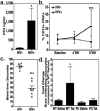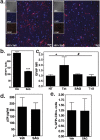Smoothened Agonist Reduces Human Immunodeficiency Virus Type-1-Induced Blood-Brain Barrier Breakdown in Humanized Mice
- PMID: 27241024
- PMCID: PMC4886511
- DOI: 10.1038/srep26876
Smoothened Agonist Reduces Human Immunodeficiency Virus Type-1-Induced Blood-Brain Barrier Breakdown in Humanized Mice
Abstract
Human Immunodeficiency Virus type-1 (HIV)-associated neurocognitive disorder is characterized by recruitment of activated/infected leukocytes into the CNS via disrupted Blood Brain Barrier (BBB) that contributes to persistent neuro-inflammation. In this report, humanized NOD/scid-IL2Rγc(null) mice were used to establish that impaired Sonic hedgehog (Shh) signaling is associated with loss of BBB function and neurological damage, and that modulating Shh signaling can rescue these detrimental effects. Plasma viral load, p24 levels and CD4(+) T cells were measured as markers of productive HIV infection. These mice also showed impaired exclusion of Evans blue dye from the brain, increased plasma levels of S100B, an astrocytic protein, and down-regulation of tight junction proteins Occludin and Claudin5, collectively indicating BBB dysfunction. Further, brain tissue from HIV(+) mice indicated reduced synaptic density, neuronal atrophy, microglial activation, and astrocytosis. Importantly, reduced expression of Shh and Gli1 was also observed in these mice, demonstrating diminished Shh signaling. Administration of Shh mimetic, smoothened agonist (SAG) restored BBB integrity and also abated the neuropathology in infected mice. Together, our results suggest a neuroprotective role for Shh signaling in the context of HIV infection, underscoring the therapeutic potential of SAG in controlling HAND pathogenesis.
Figures






Similar articles
-
Sonic Hedgehog mimetic prevents leukocyte infiltration into the CNS during acute HIV infection.Sci Rep. 2017 Aug 29;7(1):9578. doi: 10.1038/s41598-017-10241-0. Sci Rep. 2017. PMID: 28852071 Free PMC article.
-
The sonic hedgehog pathway mediates Tongxinluo capsule-induced protection against blood-brain barrier disruption after ischaemic stroke in mice.Basic Clin Pharmacol Toxicol. 2019 Jun;124(6):660-669. doi: 10.1111/bcpt.13186. Epub 2019 Mar 18. Basic Clin Pharmacol Toxicol. 2019. PMID: 30548093
-
Sonic hedgehog signaling is negatively regulated in reactive astrocytes after forebrain stab injury.Sci Rep. 2019 Jan 24;9(1):565. doi: 10.1038/s41598-018-37555-x. Sci Rep. 2019. PMID: 30679745 Free PMC article.
-
Roles of astrocytic sonic hedgehog production and its signal for regulation of the blood-brain barrier permeability.Vitam Horm. 2024;126:97-111. doi: 10.1016/bs.vh.2024.04.006. Epub 2024 May 19. Vitam Horm. 2024. PMID: 39029978 Review.
-
Mononuclear phagocytes mediate blood-brain barrier compromise and neuronal injury during HIV-1-associated dementia.J Leukoc Biol. 2000 Sep;68(3):413-22. J Leukoc Biol. 2000. PMID: 10985259 Review.
Cited by
-
Neuroinflammation generated by HIV-infected microglia promotes dysfunction and death of neurons in human brain organoids.PNAS Nexus. 2024 Apr 29;3(5):pgae179. doi: 10.1093/pnasnexus/pgae179. eCollection 2024 May. PNAS Nexus. 2024. PMID: 38737767 Free PMC article.
-
The Hedgehog Signaling Pathway Emerges as a Pathogenic Target.J Dev Biol. 2017 Dec;5(4):14. doi: 10.3390/jdb5040014. Epub 2017 Nov 28. J Dev Biol. 2017. PMID: 29214147 Free PMC article.
-
Novel Mechanism of Microvesicle Regulation by the Antiviral Protein Tetherin During HIV Infection.J Am Heart Assoc. 2020 Sep;9(17):e015998. doi: 10.1161/JAHA.120.015998. Epub 2020 Aug 21. J Am Heart Assoc. 2020. PMID: 32819189 Free PMC article.
-
Meningitic Escherichia coli α-hemolysin aggravates blood-brain barrier disruption via targeting TGFβ1-triggered hedgehog signaling.Mol Brain. 2021 Jul 19;14(1):116. doi: 10.1186/s13041-021-00826-2. Mol Brain. 2021. PMID: 34281571 Free PMC article.
-
Understanding Abnormal SMO-SHH Signaling in Autism Spectrum Disorder: Potential Drug Target and Therapeutic Goals.Cell Mol Neurobiol. 2022 May;42(4):931-953. doi: 10.1007/s10571-020-01010-1. Epub 2020 Nov 18. Cell Mol Neurobiol. 2022. PMID: 33206287 Free PMC article. Review.
References
-
- McArthur J. C. et al. Dementia in AIDS patients: incidence and risk factors. Multicenter AIDS Cohort Study. Neurology 43, 2245–2252 (1993). - PubMed
Publication types
MeSH terms
Substances
Grants and funding
LinkOut - more resources
Full Text Sources
Other Literature Sources
Molecular Biology Databases
Research Materials
Miscellaneous

